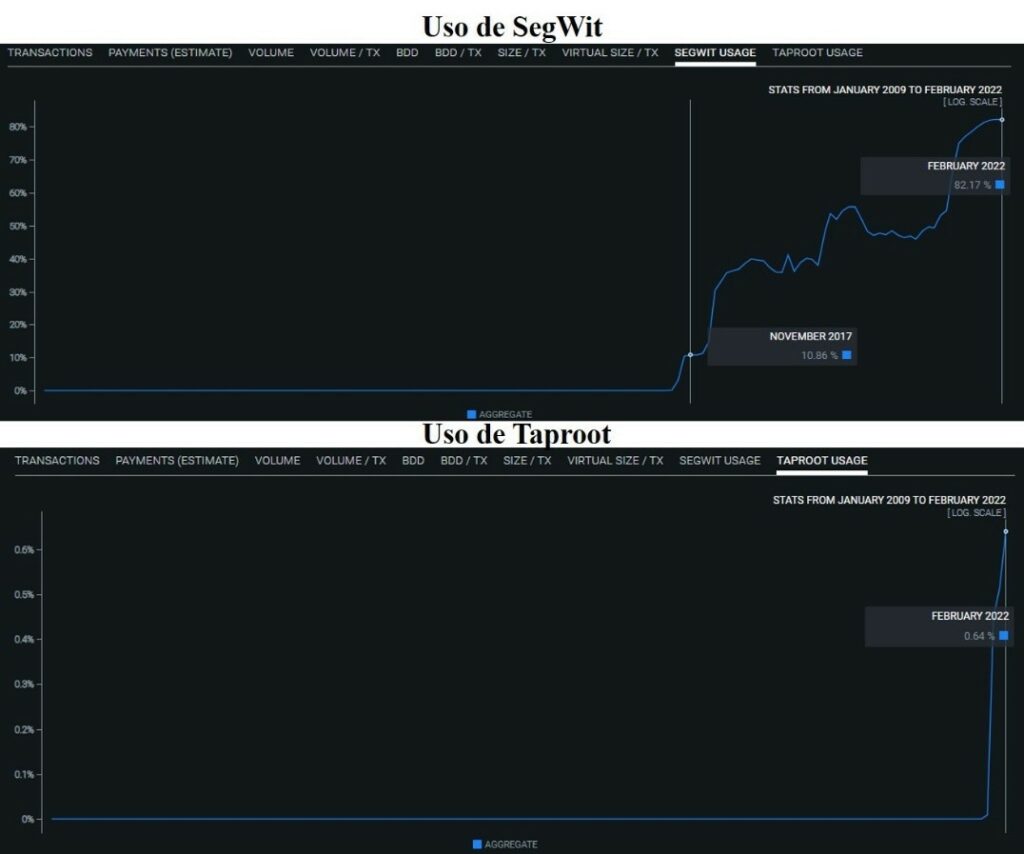Highlights:
-
SegWit, two months after its activation, already exceeded 10% usage in the Bitcoin network.
-
SegWit transactions can save Bitcoin users up to 40% in fees.
Data related to the use of SegWit and Taproot in the Bitcoin network reveals that the first of these enhancements is used in 82% of transactions. Taproot, for its part, is currently only used in 0.65% of transactions. This is its highest figure since its activation in November 2021.
SegWit (Segregated Witness or Segregated Witness) is an improvement that was activated in the Bitcoin network in August 2017. Its function is basically to separate or segregate (hence its name) certain data of a transaction from the signatures that are used to verify its validity. This adds more transactions to a block, as well as lowers network fees.
Taproot, unlike SegWit, does not influence the amount of information included in each block, but its distribution. this update allows bitcoin transactions to enjoy a higher level of privacybecause it tries to reveal only the strictly necessary information to the network.
Advertising
It could be said that the two bitcoin enhancements have a similar degree of relevance in the development and scalability of this network. However, acceptance and use of SegWit is much faster than Taproot, as shown by the statistics tool OXT.

It makes sense that SegWit is used a lot more than Taproot given that the former has been active for over four years, while the latter has only been active for a little over two months. This favors the fact that a large number of platforms, wallets and exchange houses have implemented it. However, when comparing SegWit’s use in its first few months to that of Taproot, Bitcoin’s separate witness is still far ahead.
In the graph shown above, we can see that in the first two months after the activation of SegWit, its use already exceeded 10% bitcoin transactions. This contrasts with Taproot which has yet to reach 1% usage.
Privacy is important, but savings come first
In a previous article by CriptoNoticias on the adoption of Taproot, it was already presented what could be one of the possible causes of its slow acceptance compared to SegWit. And it is that SegWit, as mentioned at the beginning of this article, affects the cost of transaction fees.
According to a report by Canadian consulting firm Veriphi reviewed by CriptoNoticias, Bitcoin users can save up to 40% on fees by using SegWit.
The taproot, being an improvement that does not have a direct impact on cost reduction or offer any purely economic benefit, seems to be less attractive. It is not that it is less important, because privacy, which is one of the main objectives of this tool, is an essential factor in the philosophy of bitcoiner.
While Taproot may show a slower evolution than SegWit in its use on the Bitcoin network, there are three elements that play a crucial role in the adoption of this improvement: education, development and time.
On the one hand, successfully promoting the adoption of Taproot so that it becomes a standard for Bitcoin transactions, it is important that people understand the benefits it brings. In addition to this, the development of tools that facilitate its use before it becomes a standard is also essential. Finally, more time should be given to the dissemination and adoption of this technology before drawing conclusions that could be hasty about its acceptance in the bitcoiner community.

“Coffeeaholic. Lifelong alcohol fanatic. Typical travel expert. Prone to fits of apathy. Internet trailblazer.”
